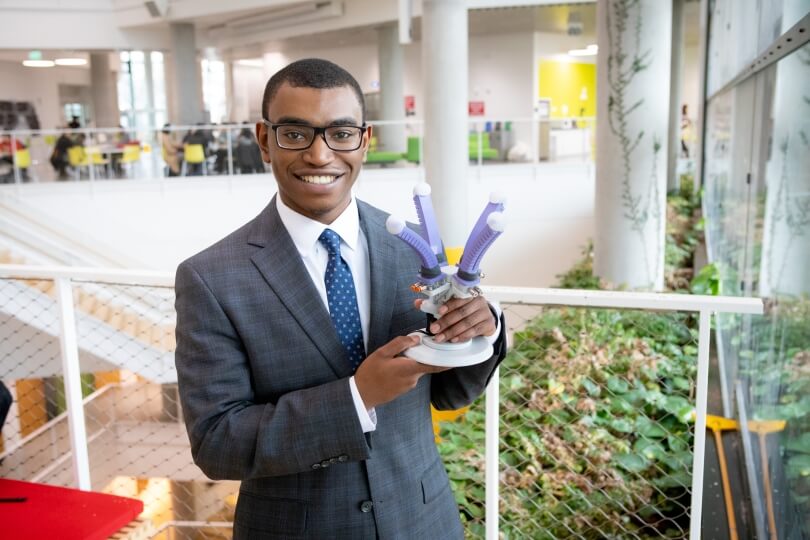Randy St. Louis, S.B. '22, built a four-fingered robotic hand that can scan and determine the best finger arrangement to safely lift objects for his senior capstone project. (Eliza Grinnell/Harvard SEAS)
Engineering Design Projects (ES 100), the capstone course at the Harvard John A. Paulson School of Engineering and Applied Sciences, challenges seniors to engineer a creative solution to a real-world problem.
Morpheus Hand: Actively-Controlled Finger Arrangement for Soft Robotic Manipulation
Randy St. Louis, S.B. ‘22, mechanical engineering
How does your hand work?
A camera scans an ID tag on an object and sends that information to a computer, which then takes that information and polls a directory of ID tags to determine the object’s geometric measurements. It then determines the best finger arrangement based on the object's geometry and sends that information to the hand’s actuator, which adjusts the fingers and grasps the object. This allows the hand to actively transition finger arrangements for manipulating a wide range of geometrically diverse items.
Where’d your project idea come from?
My graduate student mentor and I wrote a paper in the spring of 2021 that developed the proof that there is no perfect finger arrangement for lifting every object. So then we decided we should build a hand that can quickly adjust its arrangement depending on the specific object it’s trying to lift. It went from a strictly hardware project to a system project, which I think was super interesting and really allowed me to develop new skills that I can then take with me.
Why is soft robotic manipulation important?
Soft robotic manipulation brings the robotics space closer to gentle human-like dexterity, which is needed to handle tasks such as stocking shelves in a store, food preparation or setting a kitchen table – anything that deals with handling fragile items in a dextrous way. Soft robotic hands are highly compliant, low cost, hard to damage, suitable for gentle tasks and easier to control than rigid hands.
How did your project come together over the course of the year?
My first focus was on the hand, which was built to the level that I could send simple commands by November, so I took winter break to learn the Robot Operating System (ROS) program. I built the first iteration of the ROS controller package before I came back, then started working on simulations to collect item data, which took like the whole semester.
What part did you enjoy the most?
I’ve created a bridge between what was once just passive perception and data collection by the camera and an active hardware decision for the hand itself. What I believe to be the most novel part of this project is creating that bridge. Being able to work on the fly, put a new thing down and watch it do its own thing and know what to do – that high level of automation is what’s really cool for me.
What skills did you gain through your project?
Robotics in general is such an interdisciplinary field, and that’s what’s really interested me. I’m a mechanical engineer by trade, but this is the really cool stuff for me. It went from a strictly hardware project to a system project, which I think was super interesting and really allowed me to develop new skills that I can then take with me.
Press Contact
Matt Goisman | mgoisman@g.harvard.edu
